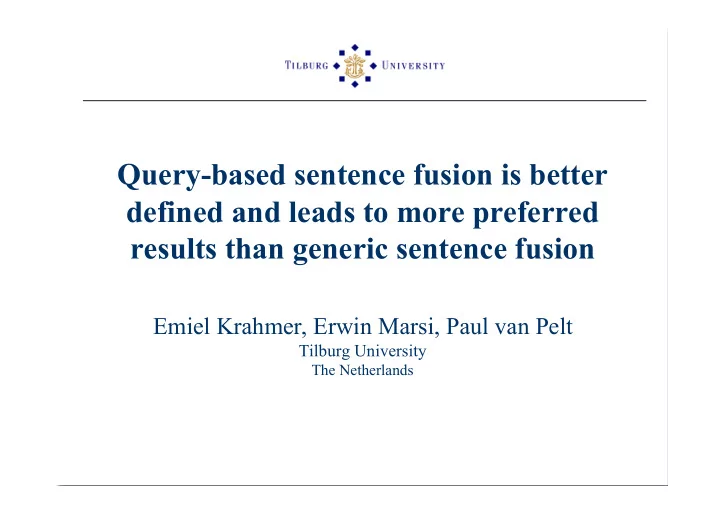

Query-based sentence fusion is better defined and leads to more preferred results than generic sentence fusion Emiel Krahmer, Erwin Marsi, Paul van Pelt Tilburg University The Netherlands
Plan 1. Introduction: sentence fusion 2. Q-driven vs. Generic sentence fusion Experiment 1: Data-collection • • Experiment 2: Evaluation 3. Summary and outlook 2
Sentence fusion Sentence fusion: given two related sentences, produce a single sentence containing the shared information (Barzilay et al. 1999, Barzilay & McKeown 2005) Text-to-text generation Motivation: Beneficial for multi-document summarization. Less redundancy, more informative summaries (Barzilay & McKeown 2005) QA applications: fuse alternative answers to obtain a more complete answer 3
Example: Generic fusion Answer 1: Posttraumatic stress disorder (PTSD) is a psychological disorder which is classified as an anxiety disorder in the DSM-IV. Answer 2: Posttraumatic stress disorder (abbrev. PTSD) is a psychological disorder caused by a mental trauma (also called psychotrauma) that can develop after exposure to a terrifying event. Fusion : Posttraumatic stress disorder (PTSD) is a psychological disorder. 4
Complication Daume III & Marcu (2004): “Generic sentence fusion is an ill-defined summarization task.” When participants are asked to fuse two consecutive sentences from a document, their results are widely different. If even human participants don’t agree, evaluating sentence fusion is tricky... 5
Our solution/hypothesis Query-based fusion: Fusing two answers guided by a question Hypothesis: Query-based fusion gives a higher agreement on the task 6
Example: Query-based fusion Question: What is PTSD? Answer 1: Posttraumatic stress disorder (PTSD) is a psychological disorder which is classified as an anxiety disorder in the DSM-IV. Answer 2: Posttraumatic stress disorder (abbrev. PTSD) is a psychological disorder caused by a mental trauma (also called psychotrauma) that can develop after exposure to a terrifying event. Q-based fusion: PTSD stands for posttraumatic stress disorder and is a psychological disorder. 7
Fusion types Marsi & Krahmer (2005): There is more than one way to fuse two sentences. Intersection Fusion: only information shared by both sentences Union Fusion: all information from both sentences (but without redundancy) Which type of fusion is best for a particular application is an open question... 8
Example: Intersection vs. union fusion Answer 1: Posttraumatic stress disorder (PTSD) is a psychological disorder which is classified as an anxiety disorder in the DSM-IV. Answer 2: Posttraumatic stress disorder (abbrev. PTSD) is a psychological disorder caused by a mental trauma (also called psychotrauma) that can develop after exposure to a terrifying event. Intersection Fusion : Posttraumatic stress disorder (PTSD) is a psychological disorder. Union Fusion: PTSD (posttraumatic stress disorder) is a psychological disorder caused by a mental trauma (also called psychotrauma) that can develop after exposure to a terrifying event. 9
Perspectives Generation perspective: – Is Q-based fusion a better defined task? – Will people agree more on union than on intersection fusions? – Is the effect of the preceding question the same for both unions and intersection fusions? User perspective: – Do users prefer concise (intersection) or complete (union) answers? – And does it matter whether they were generic of Q-based? Next: two evaluation experiments which address these questions... 10
Experiment 1: Data collection Materials: – Used QA benchmark set (100 questions, medical domain). – Correct answers were manually retrieved from the text corpus. – Selected 25 questions with multiple answers, with at least some shared information among answers Task: first perform generic fusion; next Q-based fusion Mixed between-within participants design . Two between conditions: Intersection and Union. Within each condition, both Generic and Question-based. 11
Experiment 1: Data collection (cont'd) Participants: 44 participants (24 men), average age 30.1 years. Randomly assigned to conditions. Method: web-based script. 12
Results (1) Descriptive statistics Fusion Type Length M (SD) # Ident. Q-based Intersection 8.1 (2.5)* 189* Generic Intersection 15.6 (2.9) 73 Q-based Union 19.2 (4.7)* 134^ Generic Union 31.2 (7.8) 109 * p <. 001, ^ n.s. 13
Results (2) (Normalized) ROUGE scores Generic Q-based Generic Q-based Intersection Intersection Union Union Rouge-1 .036 .068 .035 .041 Rouge-SU4 .014 .038 .018 .020 Rouge-SU9 .014 .040 .016 .020 14
In sum: Generation perspective Q-based fusions are shorter display less variation in length, yield more identical results, and have higher ROUGE scores. So: Q-based fusion is indeed a better defined task. But: does it matter? 15
Experiment 2: Evaluation Materials: – Selected 20 questions for which multiple (different) answers were obtained in Experiment I. – Per question, 4 representative answers were selected from the data collection, one for each category: Q-based Intersection, Q-based Union, Generic Intersection, Generic Fusion. Within participants design . For each of the 20 questions, participants have to rank the four answer (forced choice paradigm) Participants: 38 participants (17 men), average age 39.4 years. Method: simulated medical QA system 16
Results Average rank 1 Q-based Union 1.888* 2 Q-based Intersection 2.471* 3 Generic Intersection 2.709* 3 Generic Union 2.932 * p <. 001 17
In sum: user perspective Q-based answer fusions are systematically preferred over generic ones. Comprehensive (union) answers are preferred over concise (intersection) ones 18
Summary Is Q-based fusion a better defined task? Yes. Q-based fusions are shorter, less varied, yield more identical solutions and have higher (normalized) Rouge scores than their generic counterparts. Which type of fusions do users prefer in a QA context? Q-based Union >> Q-based Intersections >> Generic Fusions Future work: – Follow-up experiments looking at the influence of question wording and at different domains – Working on extended fusion algorithm, based on Marsi & Krahmer (2005) 19
Recommend
More recommend